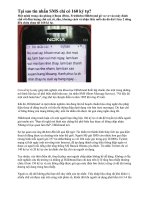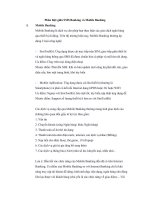AQA 74083BE SMS
Bạn đang xem bản rút gọn của tài liệu. Xem và tải ngay bản đầy đủ của tài liệu tại đây (349.17 KB, 14 trang )
A-level
PHYSICS
(7408/3BE)
Paper 3 – Section B (Electronics)
Mark scheme
MARK SCHEME – A-LEVEL PHYSICS PAPER 3 – ELECTRONICS - 7408/3BE – SPECIMEN
Mark schemes are prepared by the Lead Assessment Writer and considered, together with the relevant
questions, by a panel of subject teachers. This mark scheme includes any amendments made at the
standardisation events which all associates participate in and is the scheme which was used by them in
this examination. The standardisation process ensures that the mark scheme covers the students’
responses to questions and that every associate understands and applies it in the same correct way.
As preparation for standardisation each associate analyses a number of students’ scripts. Alternative
answers not already covered by the mark scheme are discussed and legislated for. If, after the
standardisation process, associates encounter unusual answers which have not been raised they are
required to refer these to the Lead Assessment Writer.
It must be stressed that a mark scheme is a working document, in many cases further developed and
expanded on the basis of students’ reactions to a particular paper. Assumptions about future mark
schemes on the basis of one year’s document should be avoided; whilst the guiding principles of
assessment remain constant, details will change, depending on the content of a particular examination
paper.
Further copies of this mark scheme are available from aqa.org.uk
2
MARK SCHEME – A-LEVEL PHYSICS PAPER 3 – ELECTRONICS - 7408/3BE – SPECIMEN
Physics - Mark scheme instructions to examiners
1. General
The mark scheme for each question shows:
•
•
•
•
the marks available for each part of the question
the total marks available for the question
the typical answer or answers which are expected
extra information to help the Examiner make his or her judgement and help to delineate what
is acceptable or not worthy of credit or, in discursive answers, to give an overview of the area
in which a mark or marks may be awarded.
The extra information is aligned to the appropriate answer in the left-hand part of the mark
scheme and should only be applied to that item in the mark scheme.
At the beginning of a part of a question a reminder may be given, for example: where
consequential marking needs to be considered in a calculation; or the answer may be on the
diagram or at a different place on the script.
In general the right-hand side of the mark scheme is there to provide those extra details which
confuse the main part of the mark scheme yet may be helpful in ensuring that marking is
straightforward and consistent.
2. Emboldening
2.1
In a list of acceptable answers where more than one mark is available ‘any two from’ is
used, with the number of marks emboldened. Each of the following bullet points is a
potential mark.
2.2
A bold and is used to indicate that both parts of the answer are required to award the
mark.
2.3
Alternative answers acceptable for a mark are indicated by the use of or. Different terms
in the mark scheme are shown by a / ; eg allow smooth / free movement.
3. Marking points
3.1 Marking of lists
This applies to questions requiring a set number of responses, but for which candidates
have provided extra responses. The general principle to be followed in such a situation is
that ‘right + wrong = wrong’.
Each error / contradiction negates each correct response. So, if the number of errors /
contradictions equals or exceeds the number of marks available for the question, no
marks can be awarded.
However, responses considered to be neutral (often prefaced by ‘Ignore’ in the mark
scheme) are not penalised.
3
MARK SCHEME – A-LEVEL PHYSICS PAPER 3 – ELECTRONICS - 7408/3BE – SPECIMEN
3.2
Marking procedure for calculations
Full marks can usually be given for a correct numerical answer without working shown
unless the question states ‘Show your working’. However, if a correct numerical answer
can be evaluated from incorrect physics then working will be required. The mark scheme
will indicate both this and the credit (if any) that can be allowed for the incorrect approach.
However, if the answer is incorrect, mark(s) can usually be gained by correct substitution /
working and this is shown in the ‘extra information’ column or by each stage of a longer
calculation.
A calculation must be followed through to answer in decimal form. An answer in surd form
is never acceptable for the final (evaluation) mark in a calculation and will therefore
generally be denied one mark.
3.3
Interpretation of ‘it’
Answers using the word ‘it’ should be given credit only if it is clear that the ‘it’ refers to the
correct subject.
3.4
Errors carried forward, consequential marking and arithmetic errors
Allowances for errors carried forward are likely to be restricted to calculation questions
and should be shown by the abbreviation ECF or conseq in the marking scheme.
An arithmetic error should be penalised for one mark only unless otherwise amplified in
the marking scheme. Arithmetic errors may arise from a slip in a calculation or from an
incorrect transfer of a numerical value from data given in a question.
3.5
Phonetic spelling
The phonetic spelling of correct scientific terminology should be credited (eg fizix) unless
there is a possible confusion (eg defraction/refraction) with another technical term.
3.6
Brackets
(…..) are used to indicate information which is not essential for the mark to be awarded
but is included to help the examiner identify the sense of the answer required.
3.7
Ignore / Insufficient / Do not allow
‘Ignore’ or ‘insufficient’ is used when the information given is irrelevant to the question or
not enough to gain the marking point. Any further correct amplification could gain the
marking point.
‘Do not allow’ means that this is a wrong answer which, even if the correct answer is
given, will still mean that the mark is not awarded.
3.8
Significant figure penalties
An A-level paper may contain up to 2 marks (1 mark for AS) that are contingent on the
candidate quoting the final answer in a calculation to a specified number of significant
figures (sf). This will generally be assessed to be the number of sf of the datum with the
least number of sf from which the answer is determined. The mark scheme will give the
range of sf that are acceptable but this will normally be the sf of the datum (or this sf -1).
3.9
Unit penalties
An A-level paper may contain up to 2 marks (1 mark for AS) that are contingent on the
candidate quoting the correct unit for the answer to a calculation. The need for a unit to
be quoted will be indicated in the question by the use of ‘State an appropriate SI unit for
4
MARK SCHEME – A-LEVEL PHYSICS PAPER 3 – ELECTRONICS - 7408/3BE – SPECIMEN
your answer ‘. Unit answers will be expected to appear in the most commonly agreed
form for the calculation concerned; strings of fundamental (base) units would not. For
example, 1 tesla and 1 weber/metre2 would both be acceptable units for magnetic flux
2 -2 -1
density but 1 kg m s A would not.
3.10 Level of response marking instructions.
Level of response mark schemes are broken down into three levels, each of which has a
descriptor. The descriptor for the level shows the average performance for the level.
There are two marks in each level.
Before you apply the mark scheme to a student’s answer read through the answer and
annotate it (as instructed) to show the qualities that are being looked for. You can then
apply the mark scheme.
Determining a level
Start at the lowest level of the mark scheme and use it as a ladder to see whether the
answer meets the descriptor for that level. The descriptor for the level indicates the
different qualities that might be seen in the student’s answer for that level. If it meets the
lowest level then go to the next one and decide if it meets this level, and so on, until you
have a match between the level descriptor and the answer. With practice and familiarity
you will find that for better answers you will be able to quickly skip through the lower
levels of the mark scheme.
When assigning a level you should look at the overall quality of the answer and not look to
pick holes in small and specific parts of the answer where the student has not performed
quite as well as the rest. If the answer covers different aspects of different levels of the
mark scheme you should use a best fit approach for defining the level and then use the
variability of the response to help decide the mark within the level. i.e. if the response is
predominantly level 2 with a small amount of level 3 material it would be placed in level 2.
The exemplar materials used during standardisation will help you to determine the
appropriate level. There will be an answer in the standardising materials which will
correspond with each level of the mark scheme. This answer will have been awarded a
mark by the Lead Examiner. You can compare the student’s answer with the example to
determine if it is the same standard, better or worse than the example. You can then use
this to allocate a mark for the answer based on the Lead Examiner’s mark on the
example.
You may well need to read back through the answer as you apply the mark scheme to
clarify points and assure yourself that the level and the mark are appropriate.
Indicative content in the mark scheme is provided as a guide for examiners. It is not
intended to be exhaustive and you must credit other valid points. Students do not have to
cover all of the points mentioned in the indicative content to reach the highest level of the
mark scheme
An answer which contains nothing of relevance to the question must be awarded no
marks.
5
MARK SCHEME – A-LEVEL PHYSICS PAPER 3 – ELECTRONICS - 7408/3BE – SPECIMEN
Question
Answers
Additional Comments/Guidance
Mark
2
01.1
High input resistance
01.2
Prevents static charge building up on gate (-source capacitor)
Makes gate voltage 0 V when no water/nothing between probes
2
01.3
Identifies or attempts to use potential divider equation
2
low/no energy consumption when in the ON and OFF states
OR
No input current/control by pd only.
2.4 = 12 x 1 / (R probes +1) leading to R probes = 9.6 / 2.4 = 4 MΩ
02.1
amplitude of carrier varies in phase with information/audio signal
accept labelled diagram in support
02.2
2 x 2.2 kHz = 4.4 kHz
1
1
MARK SCHEME – A-LEVEL PHYSICS PAPER 3 – ELECTRONICS - 7408/3BE – SPECIMEN
02.3
02.4
03.1
requires a large bandwidth so would limit the number of
channels/stations if low frequency carriers were used
1
Noise distorts the amplitude of signals which is difficult to reduce in
am
In fm the original signal can be recovered as long as the frequencies in
the BW are detectable since no information in the amplitude.
In AM receivers signals and noise are amplified equally.
ANY TWO
2
It is not actually connected to 0V
OR
Operational amplifier has a very large open loop gain
2
The voltage between V + and V - inputs has to be zero [or tiny ]
otherwise will saturate
03.2
V OUT = -270K / 22K x V IN = -12.3 V IN
OR
V IN = 50 x 0.01 = 0.5 V
V OUT = -12.3 x 0.5 = -6.1V
03.3
03.4
2
At 122 °C V OUT = 122 x 0.01 x 12.3 = 15.0 V
so any higher temp will give no further increase in V OUT
OR
Max V IN = 15.0/12.3 = 1.22 V
Max input temperature = 1.22/0.01 = 122 °C
WTTE
Level is fixed by controlling the pd at the + input)
OR
Turns off at higher temperature if V at + terminal higher
Output of the circuit is determined by R f /R i (V2 – V1)
2
3
When V1 = V2 the output changes from + to - (causing heater to
7
MARK SCHEME – A-LEVEL PHYSICS PAPER 3 – ELECTRONICS - 7408/3BE – SPECIMEN
switch off)
8
[valid
04.1
f 0 = 1 / (2π x √ (L x C)) C = 1 / (f 0 2 x 4π2 x L)
rearrangement]
= 1/(502 x 4π2 x 0.1)
= 5.07 (5.1) µF [µF]
04.2
Q factor = f 0 / f B
04.3
Resonant frequency becomes 25 Hz
Peak higher than original at resonant frequency
= 50 / 2.5 = 20
2
1
2
MARK SCHEME – A-LEVEL PHYSICS PAPER 3 – ELECTRONICS - 7408/3BE – SPECIMEN
05
The mark scheme gives some guidance as to what
statements are expected to be seen in a 1 or 2 mark (L1), 3 or
4 mark (L2) and 5 or 6 mark (L3) answer. Guidance provided
in section 3.10 of the ‘Mark Scheme Instructions’ document
should be used to assist in marking this question.
Mark
6
Criteria
All three aspects (physical,
interference and signal
carrying properties) covered:
A clear discussion of the
advantages/disadvantages of
the two systems in terms of
weight (and in some cases
cost) There may also be a
suggestion that optical fibres
are harder to join together.
A comparison of their relative
vulnerability to external
interference and security.
Physical
QoWC
The student presents
relevant information
coherently, employing
structure, style and sp&g
to render meaning clear.
The text is legible
External
interference
A comparison of the two
systems in terms of signal
degredation, bandwidth and
speed of transmission.
5
4
Two of the three aspects fully
covered, with some detail
missing from the third.
One aspect fully covered,
with some detail missing from
the other two
Or
The student presents
relevant information and
in a way which assists the
communication of
Signal
carrying
properties
copper
optic fibre
corrosion
Will
corrode
unless wellprotected
Glass
doesn’t
corrode
weight/ cost
etc
Copper
heavier/
more
expensive/
easy to join
Thinner and
less
expensive.
Harder to
join
security
Can be
‘tapped’
without
breaking
cable
Cannot be
tapped
(unless
cable broken
into)
electromagn
etic
interference
Can pick
up noise/
cross talk
Immune
from
noise/can be
used in
‘noisy’
environment
s
signal
degradation/
attenuation
High
attenuation
Low
attenuation
but pulses
can suffer
6
9
MARK SCHEME – A-LEVEL PHYSICS PAPER 3 – ELECTRONICS - 7408/3BE – SPECIMEN
Two aspects fully covered,
with little or no relevant
information about the third.
3
All three aspects partially
covered, with some detail
missing from each
meaning. The text is
legible. Sp&g are
sufficiently accurate not to
obscure meaning.
Or
One aspect fully covered,
with little or no relevant
information about the other
two
10
2
Two aspects partially
covered, with little or no
relevant information about the
third.
1
One aspect partially covered,
with little or no relevant
information about the other
two.
0
Little or no relevant
information about any of the
three aspects.
The student presents
some relevant information
in a simple form. The text
is usually legible. Sp&g
allow meaning to be
derived although errors
are sometimes
obstructive.
The student’s
presentation, spelling
punctuation and grammar
seriously obstruct
understanding.
smearing
bandwidth/in
fo carrying
capacity
Relatively
low/fewer
channels
greater infocarrying
capacity/mor
e
channels/po
ssibility of
sending
more than
one signal
on optic
fibre eg data
+ talk
MARK SCHEME – A-LEVEL PHYSICS PAPER 3 – ELECTRONICS - 7408/3BE – SPECIMEN
06.1
Q
0
� .B
�
A
1
1
0
0
0
0
0
1
0
0
0
0
0
1
0
1
1
�
B
A.B
0
�
A
1
0
1
1
1
0
1
1
A
B
0
1
Both correct
First line Q = 1
Third line Q = 0
11
MARK SCHEME – A-LEVEL PHYSICS PAPER 3 – ELECTRONICS - 7408/3BE – SPECIMEN
06.2
3
12
MARK SCHEME – A-LEVEL PHYSICS PAPER 3 – ELECTRONICS - 7408/3BE – SPECIMEN
13
aqa.org.uk
Copyright © 2014 AQA and its licensors. All rights reserved.
AQA Education (AQA) is a registered charity (registered charity number 1073334) and a company limited by guarantee registered in
England and Wales (company number 3644723). Registered address: AQA, Devas Street, Manchester M15 6EX
8 October 2014









